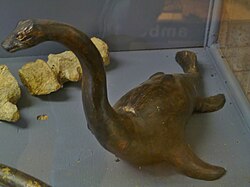Biology:Microcleidus
| Microcleidus | |
|---|---|

| |
| Fossil M. homalospondylus | |
| Scientific classification | |
| Domain: | Eukaryota |
| Kingdom: | Animalia |
| Phylum: | Chordata |
| Class: | Reptilia |
| Superorder: | †Sauropterygia |
| Order: | †Plesiosauria |
| Family: | †Microcleididae |
| Genus: | †Microcleidus Watson, 1909 |
| Type species | |
| Plesiosaurus homalospondylus (Owen, 1865)
| |
| Other species | |
| |
| Synonyms | |
|
M. macropteus
M. tournemirensis
| |
Microcleidus is an extinct genus of sauropterygian reptile belonging to the Plesiosauroidea. The species has 40 neck vertebrae and a short tail of 28 vertebrae. Fossils of the genus have been found in France, the Posidonia Shale in Germany and Luxembourg, and the Alum Shale Formation of England.
Description
The type species, M. homalospondylus, was the largest, measuring 5.1 m (17 ft) long and weighing 650 kg (1,430 lb). Other species were smaller: M. tournemirensis was about 4 m (13 ft) long and weighed 300 kg (660 lb), and M. melusinae was about 3 m (9.8 ft) long and weighed 120 kg (260 lb).[1][2][3]
Classification
Species include: Microcleidus homalospondylus (Owen 1865) and Microcleidus macropterus (Seeley 1865).
Occitanosaurus tournemirensis (originally "Plesiosaurus" tournemirensis), was named by Sciau et al. in 1990, based on a nearly complete skeleton of an animal approximately 4 meters (13 ft) long.[1] It was later found to be a species of Microcleidus.
The following cladogram follows an analysis by Ketchum & Benson, 2011.[4]
See also
References
- ↑ 1.0 1.1 Ketchum HF, Benson RBJ. Global interrelationships of Plesiosaur (Reptilia, Sauropterygia) and the pivotal role of taxon sampling in determining the outcome of phylogenetic analyses. Biological Reviews
- ↑ Valentin Fischer; Nikolay G. Zverkov; Maxim S. Arkhangelsky; Ilya M. Stenshin; Ivan V. Blagovetshensky; Gleb N. Uspensky (2020). "A new elasmosaurid plesiosaurian from the Early Cretaceous of Russia marks an early attempt at neck elongation". Zoological Journal of the Linnean Society 192 (4): 1167–1194. doi:10.1093/zoolinnean/zlaa103. https://orbi.uliege.be/handle/2268/251614.Supplementary Information
- ↑ Paul, Gregory S. (2022). The Princeton Field Guide to Mesozoic Sea Reptiles. Princeton University Press. pp. 108–109. doi:10.1515/9780691241456. ISBN 9780691193809.
- ↑ Hilary F. Ketchum; Roger B. J. Benson (2011). "A new pliosaurid (Sauropterygia, Plesiosauria) from the Oxford Clay Formation (Middle Jurassic, Callovian) of England: evidence for a gracile, longirostrine grade of Early-Middle Jurassic pliosaurids". Special Papers in Palaeontology 86: 109–129.
Bibliography
- Bardet, Nathalie; Fernandez, Marta; Garcia-Ramos, Jose Carlos; Superbiola, Xabier Pereda; Pinuela, Laura; Ruiz-Omenaca, Jose Ignacio; and Vincent, Peggy (2008). "A juvenile plesiosaur from the Pliensbackian (Lower Jurassic) of Asturias, Spain". Journal of Vertebrate Paleontology 28(1): 258–263
- [1] Plesiosaur.com 13 Oct 2006
- [2][yes|permanent dead link|dead link}}] Palæos.com 13 Oct 2006
- [3]
Wikidata ☰ Q2462673 entry
 |




